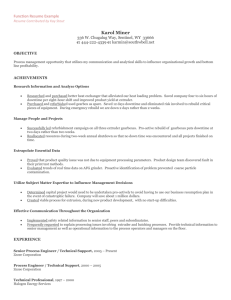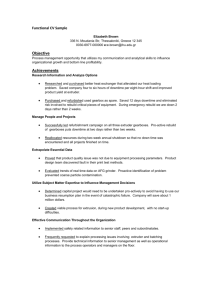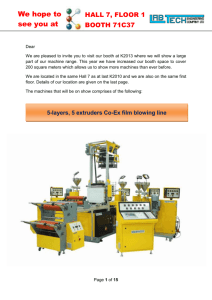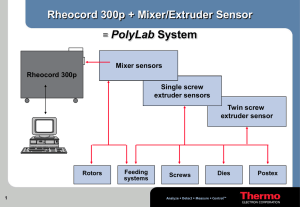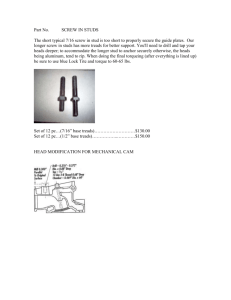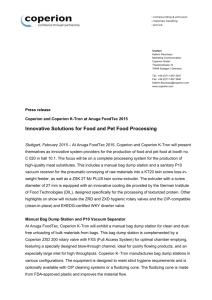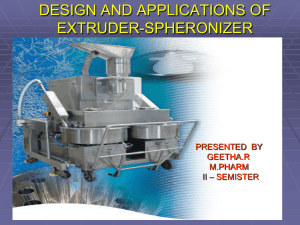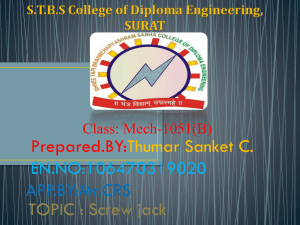Product brochure
advertisement
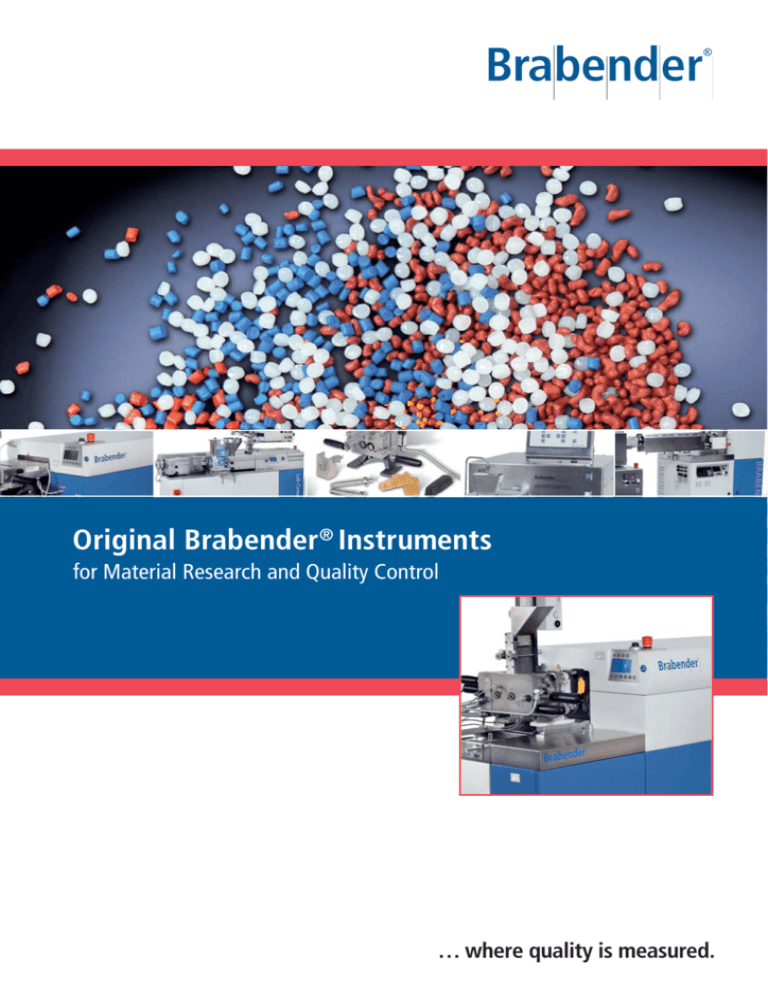
Original Brabender® Instruments for Material Research and Quality Control … where quality is measured. Company Brabender® GmbH & Co. KG, Brabender Messtechnik® GmbH & Co. KG and Brabender Technologie KG The Brabender® group The Brabender® support Founded in 1923, Brabender® belongs to the leading manufacturers of instruments and systems for testing physical properties in all fields of research, development, and industrial production. A modern application laboratory is at the disposal of all customers and interested parties for trials with their own material. All measuring systems of Brabender® can be tested under practice-oriented conditions. Today, the Brabender® group comprises four companies, each of which is responsible for its special range of development, production, and service. This allows versatility in each of the special lines. To the benefit of our customers. C. W. Brabender® Instruments Inc. An experienced expert team will assist the tests and will stay at your disposal at any time for further questions. Apart from that, numerous articles dealing with the application of the Brabender® instrument systems for manifold tests have been published all over the world during the past decades. We shall be pleased to send you a bibliography comprising about 1500 articles at present. Brabender® Applicational Laboratory Together, we will find the optimum solutions for your special problems and prove their suitability. 2 Table of contents Company 2 ® - The Brabender group - The Brabender® support Table of contents Torque rheometers 3 4-5 - Plasti-Corder® Lab-Station / Lab-Station EC - Plastograph® EC plus / Plastograph® EC Mixers - 6-8 Measuring mixers Mixer type 30 / 50 & type 30 EHT / 50 EHT Thermoplastics: PVC, PE, PP... Mixer type 350 / 350 E Special Mixer type 350 S Step-controlled Measuring Mixer Single screw extruders 9-11 - Measuring Extruders and Extrusiograph® Measuring heads - Extrusiograph® 19 / 25 D - Measuring extruder 19 / 10 DW - Grooved extruder 19 / 20 DN Stand-alone - Stand-alone extruder KE 19 / KE 30 Twin screw extruders 12-14 Docking stations - Twin screw extruderTSE 20 / 40 D - Twin screw extruder TSE 25 - Twin screw extruder TSE 35 / 17 D - Twin screw extruder CTSE Stand-alone - Mini-Compounder KETSE 12 / 36 D - Lab-Compounder KETSE 20 / 40 D and 20 / 40 D EC Software Processing / measuring die heads Downstream equipment - 15 16 17 Pelletizer Film Blowing Unit Univex FSR On-line production control 18 - Auto-Grader®: MFR, MVR - Film Quality Analyzer - Film Testing Line Carbon black and rubber testing 19 - Absorptometer ”C” - Elatest® ... where quality is measured. 3 Torque rheometers Plasti-Corder® Lab-Station / Lab-Station EC The Plasti-Corder® Lab-Station / Lab-Station EC are torque rheometers for applicational investigations or processing tasks in laboratories and for simulation. The heart of a flexible testing and simulation unit • Modular configuration The heart of the Lab-Station is the fully digital 16 kW motor which ensures fulltorque of 400 Nm over the entire speedrange of 0.2 min-1 to 350 min-1. The inverter drive provides for precise and constant speed even under this load. Further more, a torque measurement is integrated. • Multi-master system with self-intelligence modules • Self-validation • Real-time transmission of events and actual values • State of the art software for all current Windows® versions • Real multitasking • Raw material and recipe development • Quality control parallel to production • Laboratory-scale production of samples for further investigations The movable and self-centering docking stations like mixers and extruders are just coupled to this basic unit. The integration of a modern field-bus system into the new Plasti-Corder® Lab-Station / Lab-Station EC makes working a real breeze: permanent communication between control modules, sensors, and computer, easy wiring of the system components, manifold expansion facilities - just plug and play. All control modules and sensors required for additional equipment are allocated to the docking stations and are recognized automatically after coupling. Integration of the performance electronics in the individual docking stations allows preheating of the measuring head even without the basic unit or cleaning of the extruder or mixer under temperature. For manual operation, all important control data can be read on a control panel at the Lab-Station. Profit from state of the art software packages for recording, representing, and evaluating your measuring data and documenting your tests. Plasti-Corder® Lab-Station Plasti-Corder® Lab-Station EC Single Screw Extruder Type 30 Mixer Type 30 / 50 P 600 Mixer Type 350 TSE 20 / 40 CTSE Twin Screw Extruder TSE 25 4 Single Screw Extruder Type 19 Plastograph® EC plus / Plastograph® EC The Brabender® Plastograph® EC and EC plus are the economical table-top versions of the Brabender® torque rheometer applied all over the world for investigation and simulation in laboratories. The Plastograph® EC and EC plus are the perfect measuring drives for practice-oriented measurements with the Brabender® measuring heads. The economical torque rheometer for mixers and extruders • Quick and cost-effective setup • Easy connection of additional equipment such as mixers and extruders • Automatic recognition of additional equipment • State of the art software under all current Windows® versions for reliable recording and evaluation of measuring data Brabender® Plastograph® EC and EC plus serve for testing the processibility of thermoplastics, thermosets, elastomers, ceramic molding materials, fillers, pigments, and many other plastic and plastifiable materials under practice- oriented conditions, cost-effectively, reliably, with little expenditure of time and material. The Plastograph® EC plus is the advanced version for measuring mixers and extruders. With its digital 3.8 kW motor, a torque measuring range of 200 Nm, and a speed range from 0.2 to 150 min-1, the Plastograph® EC plus is the perfect measuring drive for practice-oriented measurements with the Brabender® series of 30 and 50 mixers, measuring extruder type 19, and the conical twin screw extruder. Plastograph® EC plus Plastograph® EC Conical Twin Screw Extruder Mixer Type 30 / 50 Planetary Mixer P 600 Single Screw Extruder Type 19 ... where quality is measured. 5 Mixers Brabender® measuring mixers The efficient machines for quality control and recipe development • Raw material and recipe development • Material testing • Quality control parallel to production • Optimization of the production process • Laboratory-scale production of samples for further investigations Principle Application The measuring principle is based on making visible the resistance the sample material opposes to the rotating blades. The corresponding torque moves a dynamometer out of its zero position. With Brabender® measuring mixers, you can simulate on a laboratory scale all processes like compounding, mixing, masticating, etc. that are relevant for production and processing of polymers and other plastic and plastifiable materials. Or use them for producing your sample material or for reactive processing. In compliance with the existing standards and test specifications, a typical ”Plastogram®” (torque and stock temperature vs. time) is recorded for each sample material. This diagram shows the relationship between torque (viscosity) and temperature/time in consideration of structural changes of the material. The measured data are displayed numerically as a table and/or graphically as a diagram during the measurement on the monitor and can be printed and stored. C.W. Brabender said “It is only testing, measuring, and recording as a function of time which efficiently helps to rise production quality; only this way, certain processes can be recognized which cannot be grasped with static measurements.” Brabender® measuring mixers test the processibility of thermoplastics, thermosets, elastomers, ceramic molding materials, pigments, and many other plastic and plastifiable substances. Blade geometries Select the optimum blade geometry for your special application from a large program of different blades. These comprise Banbury, cam, and roller blades which have proven successful in industrial application for many decades, but also specially optimized blade geometries for certain measuring tasks as e.g. delta blades for thermosetting materials. Evaluation • Fusion behavior of PVC • Heat and shear stability of polymers • Flow and cure behavior of crosslinking polymers acc. to DIN 53 764 • Automatic evaluation of the black incorporation time (BIT) with selectable zero point • Flow and cure behavior of elastomers • Plasticizer absorption of PVC dry blends • Liquid absorption of powders • Semi-automatic universal evaluation 6 Mixer type 30 / 50 & type 30 EHT / 50 EHT The series type 30 / type 50 and type 30 EHT / 50 EHT measuring mixers can be equipped with different blades. Within a series, the free mixer volume varies depending on the blades mounted. Due to liquid temperature conditioning, these measuring heads stand out for particularly precise and uniform heating/cooling. Measuring mixer type 30 / 50 • Easy handling and cleaning • Interchangeable blades • Liquid or electric heating • Precise and constant temperature • Conditioning up to 500 °C Mixers with the extension EHT (electric, high temperature) distinguish by their electric temperature conditioning in three control zones with compressed air cooling. As compared to liquid heated mixers, this extends the operating range to a maximum temperature of 500 °C. These measuring heads are perfectly suited for materials like PAEK and PEEK with melting temperatures of more than 300 °C. This makes these mixer types particularly interesting for research and development applications with steadily changing test materials. The EHT version is available for the series 30 and 50 mixers. The rotor speed ratio of 2 : 3 (driven to non driven) results in a high torque resolution which allows a better differentiation, especially when testing low viscosity polymers. Thermoplastics: PVC, PE, PP... Use this evaluation method for testing the fusion behavior of thermoplastic polymers. Measure material-specific Plastograms® which also permit to draw conclusions as to the history of the material. The WINMix software analyzes the curve and determines, among others, the extreme values in the torque curve (as a measure for viscosity), fusion time, gelation speed, and the mechanical energy input. These material characteristics are valuable data for incoming and final inspection or for the configuration of production processes. Fusion behavior ... where quality is measured. 7 Mixers Mixer type 350 / 350 E • Large mixer volumes • Liquid or electric heating • Precise and constant temperature • Conditioning up to 300 °C Mixer heads of the 350 series are available with liquid heating/cooling and with electric heating and air cooling. Due to the large mixer volumes of 370 to 440 cm3, these mixer heads are frequently used for producing sample compounds for subsequent tests. The material can easily be taken out and rolled out to sheets or pressed to plates. Control and document the entire compounding process from your computer. Or implement and profit from an optional step-control of each individual mixing step. Of course, these mixers can also be applied for material testing (e.g. of rubber compounds). Special Mixer type 350 S • Accurate feeding • Quick emptying • Easy cleaning The special mixer type 350 S is mainly used in the rubber and caoutchouc industry for mixing and compounding tasks or for material testing. The large free mixer volume of 370 to 440 cm3 has proven favorable for proportioning of the recipe components. Taking out of the mixing good is facilitated by the horizontal division of the middle part of this mixer. Just tilt the upper and lower halves open for removing the material and use it for subsequent tests. Extensive software packages are available for material tests like e.g. the determination of the black incorporation time (BIT). Step-controlled Measuring Mixer The series 50 and 350 measuring mixers can be equipped with a tepcontrol which offers special advantages for recipe development. Define a sequencer control with up to 20 mixing steps from your computer keyboard. The individual mixing steps can be switched as a function of registered units like • Time • Stock temperature • Energy input 8 in AND / OR functions. Additionally, several optional sensors e.g. for measuring the electric conductivity of the sample material can be connected. This makes step-controlled mixers the optimum tools for the production of elastomer compounds. Single screw extruders Measuring Extruders and Extrusiograph® The multipurpose machines for testing and processing • Applications in laboratories and small scale production • The development of new products • Testing the processing behavior for recipe development or incoming and final material inspection • Quality control during production in combination with measuring heads • Production of small tubes and profiles • Production of blown and flat films Application Heating/cooling In the measuring extruder / Extrusiograph®, the sample material is plastified under practiceoriented conditions and extruded through the die head. All measuring values such as torque, melt temperature, melt pressure are recorded continuously and represented in the form of tables and diagrams parallel to the current test. All Brabender® measuring extruders and Extrusiograph® consist of an extruder barrel with honed and nitrided bore, watercooled feed zone, and various heating or heating/cooling zones with electric heating and air cooling. The measuring extruders and Extrusiograph® have additional solenoid valves for controlled cooling air supply to the individual heating/cooling zones. The extrudate is tested for various criteria: • Uniform plastification, gloss, gels • Color dispersion and color matching • Transparency and formation of streaks, e.g. with transparent materials Temperature and pressure sensors • Swelling and contraction behaviour Two threaded bores (1/2“ x 20 UNF) opposite each other are provided at the end of the barrel of each measuring extruder for taking a thermocouple and a pressure transducer for measuring the temperature and the pressure of the melt in front of the die channel. • Segregation of individual recipe components of a compound at the die and/or at the screw`s tip (e.g. titanium dioxide) • Output per unit of time, etc. Besides, subsequent mechanical material tests can be run with the extruded specimens. Principle Screws Simulate Production Realistically on a Laboratory Scale For each measuring extruder/ Extrusiograph®, different screws are available. The screws are made of special steel, the flight basis and the lands are chromium-plated. Single- and multi-stage screws with various compression ratios and different lengths are available for testing a large range of materials. Brabender® single screw measuring extruders and Extrusiograph® are interchangeable measuring heads which, in connection with a Brabender® Plasti-Corder® Lab-Station or Plastograph® EC plus, serve for testing the extrudability of polymers and for studying thesis occurring in research and development as well as in practical application. The Brabender® modular system allows a complete instrumentation of the extruders for the control and development of raw material. Different screws, die heads, and downstream equipment fulfill all kinds of extrusion tasks. The temperature of the individual extruder zone is controlled and displayed by self-optimizing electronic temperature controllers. The Brabender® measuring extruders and Extrusiograph® can be mounted very quickly and easily to the drive unit. The torque is transmitted electronically which protects both the drive unit and the measuring extruders and Extrusiograph from damage due to overload. All Extrusiograph® have six threaded bores (1/2“ x 20 UNF) opposite each other along the barrel for taking thermocouples and pressure transducers. ® E = feed opening of the extruder L1 = feed section L2 = compression section L3 = metering section L4 = mixing section ... where quality is measured. 9 Single screw extruders Measuring heads Extrusiograph® 19 / 25 D • Variable feed units • Interchangeable feed zone • Measuring ports along the barrel The Brabender® Extrusiograph® 19 / 25 D has a barrel diameter of 19 mm and a processing length of 25 D. The Extrusiograph® is equipped with vibrating feed hopper in the standard version. Vibrating feed chutes and feed screws are available. The feed zone of the 19 mm Extrusiograph® is interchangeable and can be designed either conically grooved or as a smooth cylinder. All Extrusiograph® have six threaded bores (1/2“ x 20 UNF) opposite each other along the barrel for taking thermocouples and pressure transducers. Measuring extruder 19 / 10 DW • Feed roll • Short processing length • Expandable with pin barrel Grooved extruder 19 / 20 DN The extruder 19 / 10 DW with its feed roll and its short length of 10 D is specially used for elastomers. Frequently, it is used in combination with a pin barrel supplement and a Garvey die head. 10 • Liquid heated • Grooved barrel • Pneumatic feed unit The liquid heated extruder 19 / 20 DN has a grooved barrel over the entire length. Together with the pneumatic feed unit, it is perfectly suited for pasty materials which have a strong tendency to heat formation due to internal friction. Therefore, this extruder is frequently applied with ceramic materials. Single screw extruders Stand-alone extruders Stand-alone extruder KE 19 / KE 30 • Compact design • High perfomance extrusion • Cost-effective setup Brabender® stand-alone extruders are multi-purpose machines for testing and processing a large variety of materials. Their compact design makes these machines the ideal solution for applications in laboratories and smallscale production. Equipped with a grooved feed zone, and a barrier screw, throughputs comparable to high-performance extrusion can be reached. A large program of downstream equipment is available to build up complete processing lines. Kompaktextruder KE 30 ... where quality is measured. 11 Twin screw extruders Twin screw extruders and compounders Principle Ideal companion for compounding continously The basic steps of compounding can perfectly be realized with corotating twin screw extruders. This makes modular co-rotating twin screw extruders the ideal companion for plastics from synthesis up to recycling. Profit from the harmonized, modular conception of screws and barrels for optimally realizing all processing steps (feeding, conveying, plasticizing, dispersing, reacting, venting, pressure build-up). • Development of new material • Recipe development • Production simulation • Applications in laboratories and small scale production Advantages Intermeshing co-rotating twin screw extruders stand out for decisive processing features: • Good feeding characteristics, even with materials with poor flow properties • High conveying constancy without pulsation or irregular thermal loads • Narrow residence time spectrum of the melt within the screw area • Constantly high quality of the extrudate • High output at long energy transfer • High energy input as compared to the free screw volume The system configuration of each model can easily be adapted to the individual processing task - anytime and at low cost. • Well-defined plastification time and purposive shearing • Gentle mixing at low energy input and highquality homogenization Or combine several processing steps within a continuously working extruder and use your • Gentle material treatment without temperature peaks even at high speed • Variable shearing by using mixing and kneading elements • Kneading blocks with different disk widths and offset angles • Good control of the pressure in the melt for optimum venting • Self-cleaning of the screws by intermeshing flights 12 Brabender® twin screw extruder as a modern in-line compounder. Depending on the extruder size, on the material to be tested, and on the processing task, throughputs up to 60 kg/h can be reached. This opens up the entire application range to these extruders - from material development up to smallscale production of sheets and films. Of course, the necessary additional equipment like measuring and control units or metering systems (gravimetric, volumetric, liquid) as well as down-stream equipment is available, too, allowing for modular setup of complete extrusion lines. Expansion is possible whenever needed. Twin screw extruders Docking stations Twin screw extruder TSE 20 / 40 D • Clamshell barrel • Variable processing length • Vertical- and sidefeeding • Interchangeable screw elements • Electric heating / water cooling • Conditioning up to 400 °C The TSE 20 is available with barrel length of 40 D. The barrel length can be reduced to 30 or 20 D by means of a distance sleeve in the screw configuration to easily adapt your extruder to the individual processing task. Metering and/or vent ports can be installed every 10 D. For this purpose, the barrel is equipped with 4 ports which can be closed. Furthermore, side feeding is possible. The barrel of the TSE 20 is divided horizontally and can be tilted open on both sides. This allows visual assessment of individual processing steps and makes this extruder particularly suited for application in research and development. This extruder is also available as stand-alone version. Twin screw extruder TSE 25 • Interchangeable barrel segments • Variable processing length • Interchangeable screw elements • Through put range for laboratory and pilot plant Twin screw extruder TSE 35 / 17 D • Counter-rotating • Implying high torque • Screws with closed loop heat exchanger The counter-rotating TSE 35 was conceived for processing tasks implying a high torque. Different screw geometries are available, according to the processing task. Its fixed processing lengths of 17 D and the available torque of 200 Nm per screw make this extruder particularly suited for one- or two-step processing of difficult material. The corotating twin screw extruder TSE 25 with a barrel diameter of 25 mm is a true allrounder among the extruders. With its variable processing length of 22 to 48 D, the TSE 25 can be used for multistage compounding tasks, as pilot plant, for reactive extrusion, and for recipe development. A special software helps to build up the screws from a construction kit so as to perfectly suit the respective application. Depending on the material, this extruder reaches throughputs of 0.6 to 50 kgs/h. Feed units and a large program of die heads and downstream equipment are available as additional equipment. Twin screw extruder CTSE • Counter-rotating • Conical screw design • Constant material transport • Degassing opening Conical twin screw extruder, counterrotating for laboratory scale production. Including venting zone and measurement of pressure / temperature inside the cylinder and at the screw tip. There are various screw geometries available. This extruder is supplied as counterrotating version. ... where quality is measured. 13 Twin screw extruders Stand-alone extruders Mini-Compounder KETSE 12 / 36 D • Extremly small material amount processing • Clamshell barrel • Vertical- and sidefeeding • Interchangeable screw elements The Brabender® Mini-Compounder KETSE 12 / 36 D is a co-rotating twin screw extruder miniature with application to the chemical as well as to the pharmaceutical industry to develop new products. Almost each processing task and the easy handling of the system, distinguish the Mini-Compounder as an excellent laboratory apparatus. The Brabender® Mini-Compounder KETSE 12 / 36 D has an integrated drive with an output of 2.4 kW and reaches speeds up to max. 600 U/min-1. The modular screw conception offers all individual processing possibilities with minimum material requirements. Miniature screws compared with a paper clip Lab-Compounder KETSE 20 / 40 D • Clamshell barrel • Variable processing length • Vertical- and sidefeeding • Interchangeable screw elements • Electric heating / water cooling • Conditioning up to 400 °C • Compact design • Cost-effectiv setup With the new Stand-Alone KETSE 20 / 40 D, Brabender® offers a twin screw extruder as miniature scale with application to the chemical industry for material research and process simulation. The scale-down of the machine in combination with the comprehensive adaptability to almost each processing task, and the easy handling of the system, explain the distinction of the KETSE 20 / 40 D as an excellent laboratory apparatus. The clam shell barrel (length: 40 D) is divided horizontally, can be tilted open, and allows visual assessment of individual processing steps. Furthermore, a comfortable mounting of the screws and a quick cleaning of the cylinder is possible. In addition to the main metering, metering or venting ports at a barrel length of 10 D, 20 D and 30 D are available. Side feeding can be installed at 12 D and 22 D length. 14 Software User-optimized software With program modules like • WINMIX (mixer applications) • WINEXT (extruder applications incl. capillary rheometry) • WINAG (on-line testing of melt index and film purity), etc. The user-optimized Windows® software allows recording of process data and evaluation of the test results according to the state of the art. On-line diagrams give a quick survey of the test data and evaluation results already during the running test. The users of Brabender® instruments have a high degree of system-technical intelligence on hand. Special data correlation programs permit a direct comparison of the result of different test series with each other. Memorization of the measuring values in MS Access® database format and a real 32-bit software ensure quickness, safety, and a high flexibility combined with easy handling of the system. Plastogramm® Correlation of flow curves from round and slot capillary tests ... where quality is measured. 15 Processing / measuring die heads Processing / measuring die heads Principle Mounting and interchanging of the die heads at the extruder or Extrusiograph® is very easy: just fix them with the ring nut at the extruder barrel. The die heads are made of extremely corrosionresistant steel and are heated electrically in the standard version. However, if you need a liquid heated design for a special application, just ask us. All die heads have threaded bores for taking melt temperature and/or pressure transducers. Most of the die heads can be used vertically and horizontally. Single strand die head Rheometric slot capillary die head Round die assembly for extruding a rod or a filament. Capillary viscometer slot die assembly for scientific viscometric tests. Tubing die head Rheometric round capillary die head Tube die assembly for extruding a tube or a hose. Capillary viscometer round die assembly for scientific viscometric tests. Flexlip die head with coathanger Garvey die head Flat sheet die assembly for extruding a sheet or a film. The thickness of the die gap is variable. Principle of the spiral mandrel die head Garvey die assembly for testing special injection properties according to ASTM D 2230. Swelltest Optoelectronic thickness measuring device for round strands for testing the swell behaviour of polymers. Film blowing die assembly with cooling ring for testing the processibility of thermoplastics. 16 Downstream equipment Pelletizer • Adjustable pellet size • Low-noise operation • Easy discharge The pelletizer can handle up to 4 strands with diameters of 1 to 4 mm. The control of the cutting speed as well as the take off speed allow to adjust the pellet size. Film Blowing Unit • Realistic production simulation • Expandable with Film Quality Analyzer Depending on the material, common blowing ratios are 1 : 2 up to 1 : 4. Further features are its low-noise operation and its perfected design, including e.g. a drawer system for easy discharge. An additional Film Quality Analyzer mounted into the film blowing tower enables simultaneous purity tests. Air showers are available for drying the strands after a water bath. Univex • Excellent film quality • High take off speed • Accurate temperature conditioning The Univex can take off, cool, and wind up flat films up to a max. film speed of 30 m/min. Liquid temperature conditioning of the nip rolls positively influences e.g. crystallization processes. The Univex can be controlled manually or through PC (via Canbus). The Film Blowing Unit serves for simultaneous blowing, cooling, taking off, and winding up of extruded blown films and for exactly adjusting the hose diameter and the film thickness. FSR • Film, sheet or ribbon take off • Accurate temperature conditioning The Take-off Unit with integrated inverter drive can take off film sheets and ribbons up to a max. film speed of 10 m/min. The FSR can be controlled manually or through the PC (via CAN bus). It is adjustable for height on a movable base frame including safety device. The Liquid Temperature conditioning is intended for a regulation between 10 - 180° C. ... where quality is measured. 17 On-line production control Auto-Grader®: MFR, MVR • Objective • Continuous • Real-time testing • Integration into process control system Film Quality Analyzer The Auto-Grader® continuously determines the melt index, film purity, and transparency - within seconds online with polymer production. Self-optimizing and automatic operation ensures optimum adaptation to the polymer to be tested. All relevant data are stored in a database and can be transmitted to a process control system. • Objective • Continuous • Detection of black spots, gels and fisheyes • Evaluation of film quality note When production changes over to a new charge, the Auto-Grader® allows to exactly determine the time when the product meets the specification. This minimizes the portion of “out-of specification” material. The Film Quality Analyzer tests the purity of transparent films. Apart from transparency, the content of gels, impurities, black specks, and fisheyes is tested. All particles detected are sized and allocated to size classes. As a result, you get the size distribution and the impurity development over time. Extrapolations to the material area, weight, and volume are possible as well. The standard version permits to determine particles with a minimum diameter of 19 μm. In special cases, resolutions down to 5 μm have been realized. The minimum film transparency may go down to 20 %. The system is open to expansion for running further on-line measurements, e.g. of color, haze, etc. Film Testing Line • Modular built extrusion line • Single screw extruder • Integrated film quality analyzer FQA CCD camera 4096 pixel • FSR take off for film sheet ribbon • Detection of black spots, gels and fisheyes • Evaluation of film quality note 18 The flat film from the measuring extruder is led through inbetween a light source and a high-resolution electronic camera where it is measured. The pictures are analyzed by an intelligent data transfer interface. The picture signals and the processed measuring values are transferred to the computer. The test and evaluation results are shown on the monitor and printed. Carbon black and rubber testing Absorptometer ”C” Precise and reproducible absorption test • Frequency inverter drive unit with precise torque measurement • High-precision measuring mixer with special blades • Cooling jacket with temperature indication for mixer (option) • High-precision burette, sequencer controlled titration rate for optimum test procedure The established Brabender Absorptometer ”C” for running precise and reproducible absorption tests fully meets ASTM D 2414 including new procedures B and C as well as ASTM D 3493. The principle consists in measuring the resistance which the carbon black puts up against the rotating blades during oil addition and in determining the absorption. The high-presision burette adds liquid as a titrant to the powder sample in the mixing chamber. As the liquid wets the sample, three distinct phases can be observed in the torque curve: During the free flowing phase, liquid is absorbed into the structure of the carbon black. Upon absorption of sufficient liquid, the particles begin to adhere to each other and form agglomerates. Resistance to mixing rises, indicated by a sharp increase in torque. A maximum torque (saturation) is reached, follwed by a state change from liquid into solid to solid into liquid. The oil absorption number of carbon black is directly related to the processing and vulcanization properties of the rubber compounds prepared with these carbon blacks. • Free flowing phase • Agglomeration phase • End phase Elatest® Compact density measurement • Fully automatically • With minimum time requirement • With a reproducible accuracy of 0.03 % (0.0008 g/cm3 absolute) The Elatest® determines the density of polymers, in particular of rubber and unvulcanized rubber compounds - a dimension which is of decisive importance for rubber processing, both during recipe development and for continuous production control. The sample material is compressed within the measuring cylinder. Any gas contained in the sample escapes during this compression process. Under a preset pressure, the moving piston reaches a position which is specific for each individual sample, i.e. the sample is compressed to its specific volume. The stroke of the piston is measured by a displacement transducer and transmitted to the computer. Elatest® with touch screen From the sample weight and volume, the computer automatically calculates the density. Use the software easily with the touch screen. Excellent reproducibility of the measured values, the ease of handling, and the reliability make the Elatest® best suited for production control as well as for research and development. ... where quality is measured. 19 Brabender® agencies all over the world. © 2013 Brabender® GmbH & Co. KG All trademarks are registered. Subject to change of design and technical modification without notice. DIN EN ISO 9001 TAW Cert Brabender® GmbH & Co. KG Kulturstr. 51-55 · 47055 Duisburg · Germany Phone: +49 203 7788-0 · Fax: +49 203 7788-101 E-Mail: plastics-sales@brabender.com www.brabender.com … where quality is measured. 25055-E / Brabender C / Übersicht / 01 / 2013 Zert.Nr.: 18020513
